Press
Space 1999 on satellite
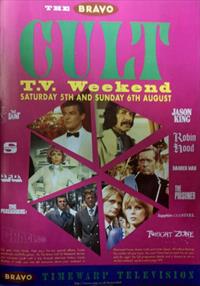
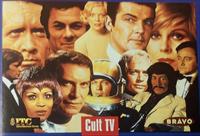
In the 1990s, UK viewers suddenly gained hundreds of new satellite channels. One, Bravo, specialized in ITC Entertainment series, and in 1995 it started to show Space: 1999. It was first previewed in a "Cult TV weekend" at the start of August (adverts above), followed by twice-weekly slots in September. Two of the major satellite listings magazines ran features to promote the show.
Satellite TV Europe September 1995 p18-19
Satellite TV Europe was a 1990s UK magazine which called itself "Britain's Biggest Selling Satellite Guide", mostly filled with monthly schedule listings for more than 100 satellite channels, with articles on sport, music, and movies. The September 1995 issue had a "Space Week" feature (the Discovery Channel had a 3-part science of Star Trek documentary), tied to Bravo launching Space: 1999.
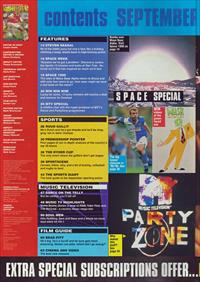
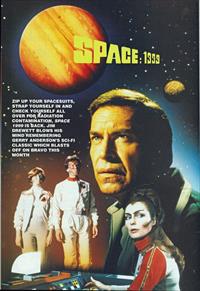
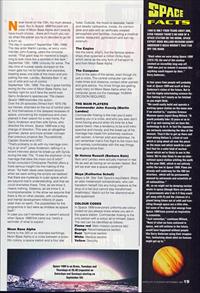
Zip up your spacesuits, strap yourself in and check yourself all over for radiation contamination, Space: 1999 is back. Jim Drewett blows his mind remembering Gerry Anderson's sci-fi classic which blasts off on bravo this month
Never travel on the 13th, my mum always says. But in Space: 1999 the poor old crew of Moon Base Alpha don't exactly have much choice... there ain't much you can do when the planet you're on decides to go for a burn up.
The day in question? September 13th, 1999.
The day actor Martin Landau, er sorry, commander John Koenig, utters the immortal words: "That giant leap for mankind is beginning to look more like a stumble in the dark."
September 13th, 1999. Unlucky for some. The day tons of nuclear waste dumped on the moon gets too hot to handle and explodes, blasting away one side of the moon and propelling the rest, Landau, Barbara Bain 'n' all, out of orbit and out of control.
September 13th, 1999. The day it goes horribly wrong for the crew of Moon Base Alpha, but horribly right for sci-fi fans the world over. Gerry Anderson's spectacular '70s classic Space: 1999 explodes into action.
Over the 24 episodes (filmed from 1975-78) our heroes, stranded on the out of control planet, find themselves in the deepest recesses of space, uncovering the mysterious and unexplained in their search for a new home. For Gerry Anderson and then wife Sylvia, who directed the shows, Space: 1999 was a big change of direction. This was an altogether grimmer, darker and more sinister concept than previous projects like Thunderbirds, Captain Scarlet and UFO.
"That's probably to do with my marriage coming to an end!" jokes Anderson, talking in a recent interview about his break-up with Sylvia during the late '70s. "It was the explosion of my marriage that blew the moon out of orbit!"
Script consultant Christopher Penfold offers a more serious insight into the making of the show: "As fresh ideas were tossed around when we were writing the scripts we realised that there are mysteries in outer space which are beyond man's understanding, and that we could dramatise these. Time, as we know it, means nothing. Distance, as we know it, is incomprehensible. In the show we assume that there is life on other planets, with civilisations and mental development millions of years older than on earth. The possibilities for the programme in fact were as limitless as space itself."
In case you can't remember, or weren't around when Space: 1999 first came out, here's a reminder of what to expect:
Home to the 300 or so stranded earthlings, Moon Base Alpha is a cross between a scientific colony, a space station and a four star hotel. Outside, the moon is desolate, harsh and deadly radioactive. Inside, it's comfortable and safe with an artificially created atmosphere and facilities, including a medical centre, restaurant, gymnasium and sun ray solarium.
Not the band, silly(!), but the famous spaceships (that spawned a million Dinky toys) which serve as the only form of transport to and from Moon Base Alpha.
One of the stars of the series, even though it's just a voice. The central computer can estimate times and distance, contact other planets and give advice. You know things are getting really hairy on Moon Base Alpha when the computer gives out the message: HUMAN DECISION REQUIRED.
Commander Koenig is the man you'd want leading you in a crisis, and who you also don't mind having around when it's time for a few space beers. Has a tendency to be a bit introspective and moody, and the break-up of his marriage has made him extremely cautious with women. A former pilot and astronaut, he can remember man's first flight to the moon but isn't entirely comfortable with the way things have gone since then.
Bain and Landau were actually married in real life as well as having an on-screen liaison. But will we ever see a space wedding?!
Maya is Mr Star Trek Spock's equivalent. She's an alien metamorph extraordinaire, who can transform herself into any living creature at the drop of a hat (but cannot stay transformed indefinitely). Watch out for her diamond-studded eyebrows!
In Space: 1999 everyone's uniforms are colour coded so you always know where you are in the space station. Commander Koenig is the only person with a colour all to himself, black. The rest can be identified as follows:
1999 is only four years away and, even though there's no sign of a space station on the moon, space expert Doug Millard reckons Gerry Anderson's ideas weren't that far off the mark
"Back when we were doing Space: 1999 [1975-78] the end of the century seemed an incredibly long way off. 1999 was just so remote it seemed like anything could happen by then." Gerry Anderson.
In four years time people will probably look at Space: 1999 and scoff at Gerry Anderson's vision of the future. But in fact his highly entertaining science-fiction fantasy isn't nearly as far fetched as you might think.
"We could easily build and operate a working space station on the moon now if we wanted to," explains Science Museum space expert Doug Millard. "It would probably take 10 years or so to get it up and running but we have the technology to do it. In fact the Japanese are seriously considering the idea at the moment. They'd like to get up there and start mining Helium 3, a kind of rock which is lying about all over the place on the moon and which would be a perfect fuel for a safer kind of nuclear power which we're likely to see in the future. We're also likely to see an international space station orbiting the earth by the year 2002, which is not entirely unlike the one in Space: 1999. Plans are already well underway for the 400 ton structure, which will be permanently manned by astronauts and scientists of all nationalities."
OK, so we might not be dumping nuclear waste in space (though there are plenty of governments who'd do it if they could get away with it) and the chances of a planet being blown out of orbit and travelling through space are a little slim, but some of the ideas that emerge from Space: 1999 have proved an inspiration to scientists.
"Just remember," continues Millard, "None of what we have achieved in space, and will achieve in the future, would have happened without people like Gerry Anderson using their imagination, fantasising about what we humans might get up to."
What Satellite TV September 1995 p64-66
What Satellite TV was a competing magazine, again based around listings, but with more features on satellite hardware. It did a substantial two-part article. The listing for September 5th on p71 was less complimentary: Twenty years on and this classic sci-fi series hasn't aged a bit. Well, perhaps it has a little bit. Oh alright, then, it's dated, tacky and hammy as hell - but it's also great fun, nostalgia ridden and on Bravo tonight at 8pm
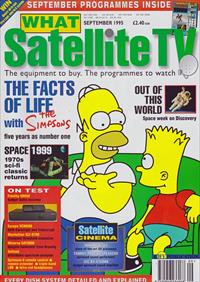
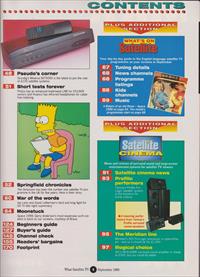
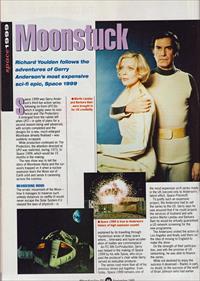
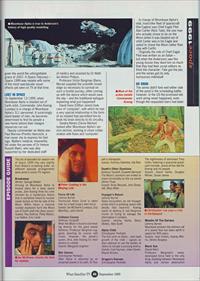
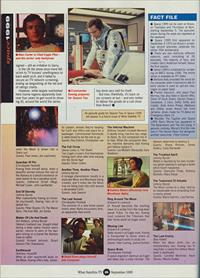
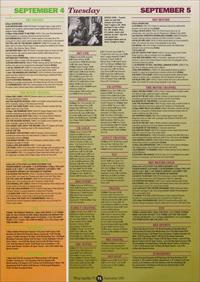
Richard Youlden follows the adventures of Gerry Anderson's most expensive sci-fi epic, Space: 1999
Space: 1999 was Gerry Anderson's third live action series, following on from UFO (to which it largely owes its existence) and The Protectors. It emerged from the rubble left when UFO- in spite of plans for a second season being well advanced, with scripts completed and the designs for a new, much enlarged Moonbase already finalised - was suddenly scrapped.
While production continued on The Protectors, the attention directed at UFO was switched, during 1973, to Space: 1999, which would be 15 months in the making.
The new show was to tell the story of Moonbase Alpha and the survivors trapped on it when a nuclear explosion tears the Moon out of Earth orbit and sends it careening across the cosmos.
The erratic movement of the Moon - how it manages to traverse such unlikely distances so swiftly (it would never escape the Solar System if it obeyed the laws of physics!) - is explained by its travelling through 'mysterious areas of deep space where... time-warp and hyper-acceleration of matter are commonplace'.
An ITC RAI Co-Production, Gerry was helped in the making of Space: 1999 by his wife Sylvia, who occupied the producer's chair while Gerry served as executive producer.
The series cost more than all of his previous shows put together. Even today, Space: 1999 remains one of the most expensive sci-fi series made in the UK (second only to Anderson's latest effort, Space Precinct!)
To justify such an expensive project, the Andersons had to sell the series to the US. Gerry says he was assured that if he could acquire the services of husband and wife actors Martin Landau and Barbara Bain he would be virtually guaranteed a US network screening for the new programme.
The Andersons visited the actors in Los Angeles and finally sold them on the idea of moving to England to make the show.
On the strength of their participation, and with the promise of US networking, he was able to finance the series.
While not destined to enjoy the success it deserved - Thanks in part, no doubt, to the success of the work of Brian Johnson (who had earlier given the world the unforgettable grace of 2001: A Space Odyssey) - Space: 1999 was replete with some of the most spectacular visual effects yet seen on TV at that time.
On September 13 1999, when Moonbase Alpha is blasted out of Earth orbit, Commander John Koenig (Landau) is in charge of Moonbase Alpha's 311 personnel. A surprisingly bland leader of men, he becomes determined to find his people a new home before their meagre resources run out.
Deputy commander on Alpha was Paul Morrow (Prentis Hancock), a man never shy to express his feelings. Matters medical, meanwhile, fell under the purview of Dr Helena Russell (Bain), who was ably supported by her dedicated staff of medics and assisted by Dr Mathias (Anton Philips).
Professor Victor Bergman (Barry Morse) supplied the scientific knowledge so necessary to survival on such a hostile journey, often coming up with the device which would save the day - and the traditional epilogue explaining what just happened!
David Kano (Clifton Jones) took care of 'computer', with which he had a very special relationship in the form of an implant that permitted him to hook his brain directly to its circuitry.
Sandra Benes (Zienia Merton) looked after Moonbase Alpha's service section, working in close collaboration with Kano and 'computer'.
In charge of Moonbase Alpha's vital, insect-like fleet of spacecraft (the Eagles) was Chief Eagle Pilot Alan Carter (Nick Tate), the one man who actually chose to be on the Moon (when it was blasted out of orbit Carter was in his Eagle and opted to chase the Moon rather than stay with Earth).
Originally the role of Chief Eagle Pilot was written as an Italian - but when the Andersons saw this young Aussie they liked him so much that they had their script editors rethink the character: Tate got the job, and the series got its only humourous individual!
The series didn't fare well either side of the pond in the scheduling battle, however. In the US the promised network airing never happened, even though the requested stars had been signed - still an irritation to Gerry.
In the UK the show once more fell victim to TV bosses' unwillingness to back adult sci-fi, and it failed to secure an ITV network screening, ending up languishing at the tail end of ratings charts.
However, while largely overlooked here (some regions apparently took over four years to get round to showing it!), around the world the series has done very well for itself.
But now, thankfully, its back on our screens at last - and who better to deliver the goods on a cult show than Bravo?
Space: 1999 can be seen on Bravo, on Tuesdays and Thursdays at 8pm, starting September 5. The episodes shown during the week are repeated at the weekend
Space: 1999 first appeared on September 4 1975 (so Bravo's screenings almost precisely celebrate the series' 20th anniversary)
There are two distinctly different seasons, each consisting of 24 episodes. The majority of fans, and creator Gerry Anderson himself, favour the first season
Space: 1999 is scheduled for screening on BBC2 during 1996. The entire series is available on ITC Video
Barbara Kelly provided the voice for the computer when it learned to talk (in early stories it used to spit-out messages on paper tape)
Prentis Hancock, who plays Paul Morrow, has also been in Doctor Who, Dixon Of Dock Green, Doctor Finlay's Casebook, Z Cars, Softly Softly and Colditz. Both Anton Philips (Mathias) and Clifton Jones (Kano) hail from Jamaica. Jones made his TV debut on Emergency Ward 10
Besides The Fugitive and Space: 1999, Barry Morse has appeared in The Adventurers and The Zoo Gang. A genuine cockney, Morse's first film role was in The Goose Steps Out alongside another newcomer, Peter Ustinov
What Satellite TV December 1995 p70-72
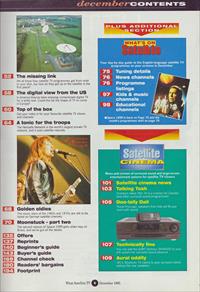
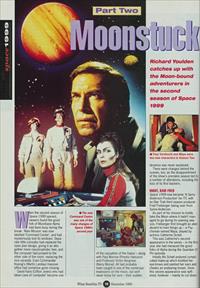
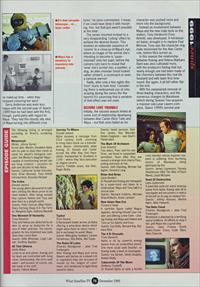
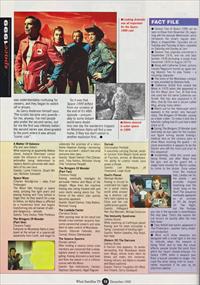
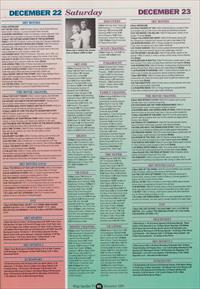
When the second season of Space: 1999 opened, viewers found the good folk of Moonbase Alpha had been busy during the break. 'Main Mission' was now labelled 'Command Center', and had mysteriously lost its windows. Separate little consoles had replaced the open plan design, giving it an altogether more claustrophobic feel, and the computer had jumped to the other side of the room, replacing the nice veranda. Even Commander Koenig's (Martin Landau) massive office had somehow gone missing.
David Kano (Clifton Jones) who had taken care of 'computer' became one of the casualties of the hiatus - along with Paul Morrow (Prentis Hancock) and Professor Victor Bergman (Barry Morse). All had probably been caught in one of the numerous explosions on the moon, but we'll never know for sure - their sudden absence was never explained.
There were changes behind the scenes, too, as the disappointment of the show's premiére season led to a number of alterations, including the loss of its first backers.
Space: 1999 now became 'A Gerry Anderson Production' for ITC with ex-Star Trek third season producer Fred Freiberger taking over from Sylvia Anderson.
As part of his mission to boldly take the Moon where it hadn't managed to go during its opening season, Freiberger first brought an alien aboard to liven things up - a Psychonian named Maya, played by actress Catherine Schell.
This was Catherine's second appearance in the series - in the first year she had menaced the good folks of Alpha during the Guardian Piri episode.
Initially Ms Schell endured complicated make-up which knotted her eye-brows and painted her ears and cheeks an endearing brown. Soon this severe appearance was softened, however - mainly to cut down on make-up time - when they stopped colouring her ears!
Gerry Anderson was even less happy with the second year of Space: 1999 than he had been with the first, though, particularly with regard to Maya. 'They had this bloody silly idea of Maya turning into different creatures,' he once commented. 'I mean, if we could have done it with morphing, fine, but that just wasn't possible at the time'.
The series resorted instead to a very disappointing 'cutting' effect to achieve the desired illusion. This involves an elaborate sequence of 'zooms' to a close-up of Maya's eye, where an image of the animal she's intending to become is 'super-imposed' onto her pupil, before the camera cuts back to reveal that 'wow' she's turned into: a panther, a dog, an alien monster (most looked rather similar!), a cockroach or even a samurai warrior!
Sadly, after only a few sights this 'trick' starts to look tired. Considering there is widespread use of rotoscoping during the series (for the beams) it's surprising that a variation of that effect was not used.
Initially, the second season hinted at some sort of relationship developing between Alan Carter (Nick Tate) and Maya - but that soon faded as his character was pushed more and more into the background.
Instead an involvement between Maya and the new male hunk on the station, Tony Verdeschi (Tony Anholt), was developed. A hot-blooded Italian, brought in to replace Paul Morrow, Tony was the character originally envisioned for the Alan Carter role, before Nick turned up.
In this season the relationship between Koenig and Helena (Barbara Bain) was also cultivated more, with the producers feeling that not nearly enough use had been made of the chemistry between this real life husband and wife team first time round. But again, it all fell rather flat in the end.
With the unexplained removal of three leading characters, and the numerous changes to Moonbase (which during Season Two acquires a massive sub-Lunar cavern complex), Space: 1999's second year was understandably confusing for viewers, and they began to switch off in droves.
As Gerry Anderson himself says: 'The scripts became very juvenile - for me, anyway. I've met people who prefer the second series, but for me the first was infinitely better; the second series was down-graded to the point where it was almost "comic cuts"'.
So it was that Space: 1999 drifted from our screens at the end of its 48th episode - presumably to some distant world were doubtless one day the wanderers trapped on Moonbase Alpha will find a new home. If they too don't vanish in another explosion first...
Season Two of Space: 1999 can be seen on Bravo from November 28, beginning with the episode Metamorph, which introduces the show's regular alien, Maya, a shapeshifter. Episodes are on Tuesday and Thursday at 8pm, repeated on Saturday and Sunday at 1pm
Season Two originally premiéred in September 1976, and ran until September 1978 (including a break from December 1976 to August 1977!)
Along with Catherine Schell, actress Yasuko Nagazumi turned up again during Season Two to play Yasko - a recurring character
The voice of the Moonbase computer was provided by Barbara Kelly
Catherine Schell first visited the Moon in 1970 when she appeared in the film Moon Zero Two. At that time she used her full name Catherina von Schell. She has also appeared in Dr Who, One By One and a sitcom called Mog, among many others
Watch out for the telescope' which appears in the series' only two-part story, The Bringers Of Wonder, posing as a laser cutter. To make it look like a futuristic cutting tool it's just had a label stuck on it!
During The Bringers Of Wonder (part two) keep an eye open for the mysterious figure lurking beside Koenig's medical bed as the camera pans to show Maya stunning the guard - on close examination it appears to be the Doctor who left the room just prior to this sequence!
Incidentally, while this scene was being filmed, just after Maya fired the gun, and as the guard fell, a stage hand shouted for Martin Landau to come to the phone. Once untied from the medical bed, Landau ran for the phone. - and promptly tripped head-long over the 'body' lying on the floor! The sequence eventually appeared as an out-take in It'll Be Alright On The Night, the footage but you see in the episode is nevertheless the only take. That's the reason the cut occurs so quickly after the man falls down
Tony Anholt had earlier appeared in The Protectors - another Gerry Anderson production
Most sci-fi show weapons are designed with a small light in the end to indicate when the weapon is being 'fired' and to help the visual effects people locate the point from which the 'beam' should emerge. For Space: 1999, when a weapon was fired, a buzzer sounded on stage. This cued the actor being shot to react - rather important if he was be shot from behind
Space: 1999 copyright ITV Studios Global Entertainment